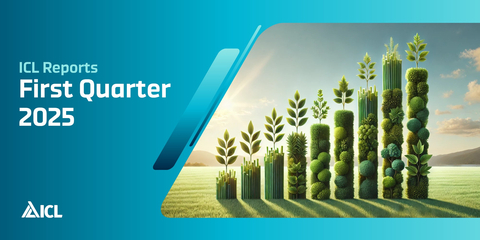ICL Reports First Quarter 2025 Results
Sales of

“ICL delivered sequential increases in first quarter sales, adjusted EBITDA and EPS, with results led by our specialties-driven businesses. Our Industrial Products, Phosphate Solutions and Growing Solutions businesses also reported year-over-year growth in sales and EBITDA, generally driven by higher volumes with limited price improvement. For our Potash segment, prices were lower year-over-year, as expected, with supply more heavily weighted toward our annual 2024 contracts with
The company reiterates its guidance for full year 2025, with specialties-driven EBITDA of between
Key Financials
First Quarter 2025
US$M Ex. per share data |
1Q'25 |
1Q'24 |
Sales |
|
|
Gross profit |
|
|
|
|
|
Operating income |
|
|
Adjusted operating income (1) |
|
|
|
|
|
Adjusted operating margin (1) |
|
|
Net income attributable to shareholders |
|
|
Adjusted net income attributable to shareholders (1) |
|
|
Adjusted EBITDA (1) |
|
|
Adjusted EBITDA margin (1) |
|
|
Diluted earnings per share |
|
|
Diluted adjusted earnings per share (1) |
|
|
Cash flows from operating activities (2) |
|
|
(1) |
Adjusted operating income and margin, adjusted net income attributable to shareholders, adjusted EBITDA and margin, and diluted adjusted earnings per share are non-GAAP financial measures. Please refer to the adjustments table and disclaimer. |
(2) |
See "Condensed consolidated statements of cash flows (unaudited)" in the appendix below. |
Industrial Products
First quarter 2025
-
Sales of
$344 million $335 million -
EBITDA of
$76 million $72 million - Year-over-year growth driven by better volumes in flame retardants.
Key developments versus prior year
-
Flame retardants: Overall sales increased, with bromine-based product sales up slightly, as higher volumes offset lower prices. Sales of phosphorous-based solutions increased, with higher volumes mainly in
Europe and theU.S. , and overall higher prices. Both the electronics and construction end-markets remained somewhat soft, in the first quarter. - Elemental bromine: Higher volumes drove an increase in sales, offsetting lower market prices.
- Clear brine fluids: Sales lower, despite solid trends and continued strength in oil and gas demand in the Gulf of America, while competition increased in the Eastern Hemisphere.
- Specialty minerals: A slight increase in sales was driven by higher volumes and prices for magnesium chloride used in deicing, while there was a decrease in specialty magnesia demand for pharma and food applications.
Potash
First quarter 2025
-
Sales of
$405 million $423 million -
EBITDA of
$118 million $124 million -
Grain Price Index decreased
12.1% year-over-year, with corn up9.1% , while rice, soybeans and wheat were down22.2% ,15.1% and8.1% , respectively. On a sequential basis, the Grain Price Index increased1.0% , with corn, soybeans and wheat up10.5% ,3.3% ,4.5% , respectively, while rice declined6.8% .
Key developments versus prior year
-
Potash price:
$300 -
Up
5% sequentially but down7% year-over-year. -
ICL continued to fulfill its 2024 annual contracts with
China andIndia , and the prices in these agreements were lower than market rates, which improved as the first quarter progressed.
-
Up
-
Potash sales volumes: 1,103 thousand metric tons.
-
Increased by 19 thousand metric tons year-over-year, with higher volumes mainly to
Brazil andChina .
-
Increased by 19 thousand metric tons year-over-year, with higher volumes mainly to
-
ICL Dead Sea
- Production decreased, with continued operational challenges primarily related to external forces.
-
ICL Iberia
- Production lower, while efficiency efforts remain on-track.
Phosphate Solutions
First quarter 2025
-
Sales of
$573 million $559 million -
EBITDA of
$139 million $131 million - Year-over-year growth driven by strength in commodities, while specialties results were lower but in-line with market dynamics.
Key developments versus prior year
- White phosphoric acid: Sales increased, as strong volume growth in all regions offset lower prices.
- Industrial phosphates: Sales increased, as higher volumes in all major regions offset lower prices related to decreasing cost inputs.
- Food phosphates: Despite higher volumes, sales decreased due to lower market prices, which reflected reduced raw material costs.
-
Battery materials: Sales decreased, as higher prices in
China were unable to offset lower volumes. In January, ICL signed a strategic agreement with Shenzhen Dynanonic to establish battery materials production inEurope , and in early April, the company formally commissioned its Battery Materials Innovation and Qualification (BMIQ)Center inSt. Louis . -
Commodity phosphates: Overall phosphate prices were stable to higher, as global demand remained firm and as
China continued to restrict exports.
Growing Solutions
First quarter 2025
-
Sales of
$495 million $479 million -
EBITDA of
$47 million $42 million - Continued focus on innovative, regional solutions helped drive year-over-year growth.
Key developments versus prior year
-
Brazil : Sales increased on both higher volumes and prices, however, product mix and exchange rate fluctuations caused a decrease in gross profit. -
Europe : Sales decreased on lower volumes, but gross profit increased, due to higher prices and improved product mix. -
North America : Sales increased, with higher volumes – in part due to the 2024 acquisition of Custom Ag Formulators – and slightly higher prices contributing to increased gross profit. -
Asia : Sales increased, as higher volumes drove higher gross profit. -
Product trends: Specialty agriculture sales increased on both higher volumes, in
Europe , theU.S. ,China andBrazil , and higher prices – mainly inBrazil . Turf and ornamental sales increased, with turf and landscape experiencing both higher volumes and prices, while ornamental horticulture volumes declined in theU.S. andChina . - In early April, ICL acquired a leading ag-biologicals company, and this acquisition further advanced the company’s stated goal of expanding its Growing Solutions product offerings and to position the business for further growth in new and adjacent end-markets.
Financial Items
Financing Expenses
Net financing expenses for the first quarter of 2025 were
Tax Expenses
Reported tax expenses in the first quarter of 2025 were
Available Liquidity
ICL’s available cash resources, which are comprised of cash and deposits, unutilized revolving credit facility, and unutilized securitization, totaled
Outstanding Net Debt
As of March 31, 2025, ICL’s net financial liabilities amounted to
Dividend Distribution
In connection with ICL’s first quarter 2025 results, the Board of Directors declared a dividend of
About ICL
ICL Group Ltd. is a leading global specialty minerals company, which creates impactful solutions for humanity's sustainability challenges in the food, agriculture and industrial markets. ICL leverages its unique bromine, potash and phosphate resources, its global professional workforce, and its sustainability focused R&D and technological innovation capabilities, to drive the company's growth across its end markets. ICL shares are dual listed on the New York Stock Exchange and the Tel Aviv Stock Exchange (NYSE and TASE: ICL). The company employs more than 12,000 people worldwide, and its 2024 revenue totaled approximately
For more information, visit ICL’s website at icl-group.com.
To access ICL's interactive CSR report, visit icl-group-sustainability.com.
You can also learn more about ICL on Facebook, LinkedIn, YouTube, X and Instagram.
Guidance
(1a) The company only provides guidance on a non-GAAP basis. The company does not provide a reconciliation of forward-looking adjusted EBITDA (non-GAAP) to GAAP net income (loss), due to the inherent difficulty in forecasting, and quantifying certain amounts that are necessary for such reconciliation, in particular, because special items such as restructuring, litigation, and other matters, used to calculate projected net income (loss) vary dramatically based on actual events, the company is not able to forecast on a GAAP basis with reasonable certainty all deductions needed in order to provide a GAAP calculation of projected net income (loss) at this time. The amount of these deductions may be material, and therefore could result in projected GAAP net income (loss) being materially less than projected adjusted EBITDA (non-GAAP). The guidance speaks only as of the date hereof. The company undertakes no obligation to update any of these forward-looking statements to reflect events or circumstances after the date of this news release or to reflect actual outcomes, unless required by law. The company provides guidance for specialties-driven EBITDA, which includes Industrial Products, Growing Solutions and Phosphate Solutions, as the Phosphate Solutions business is now predominantly specialties focused. For the Potash business, the company is providing sales volume guidance. The company believes this information provides greater transparency, as these new metrics are less impacted by fertilizer commodity prices, given the extreme volatility in recent years.
Non-GAAP Statement
The company discloses in this quarterly report non-IFRS financial measures titled adjusted operating income, adjusted net income attributable to the company’s shareholders, diluted adjusted earnings per share, and adjusted EBITDA. Management uses adjusted operating income, adjusted net income attributable to the company’s shareholders, diluted adjusted earnings per share, and adjusted EBITDA to facilitate operating performance comparisons from period to period. The company calculates adjusted operating income by adjusting operating income to add certain items, as set forth in the reconciliation table under “Adjustments to reported operating, and net income (non-GAAP)” below. Certain of these items may recur. The company calculates adjusted net income attributable to the company’s shareholders by adjusting net income attributable to the company’s shareholders to add certain items, as set forth in the reconciliation table under “Adjustments to reported operating, and net income (non-GAAP)” below, excluding the total tax impact of such adjustments. The company calculates diluted adjusted earnings per share by dividing adjusted net income by the weighted-average number of diluted ordinary shares outstanding. Adjusted EBITDA is calculated as net income before financing expenses, net, taxes on income, share in earnings of equity-accounted investees, depreciation and amortization, and certain adjustments presented in the reconciliation table under “Consolidated adjusted EBITDA, and diluted adjusted earnings per share for the periods of activity” below, which were adjusted for in calculating the adjusted operating income.
You should not view adjusted operating income, adjusted net income attributable to the company’s shareholders, diluted adjusted earnings per share or adjusted EBITDA as a substitute for operating income or net income attributable to the company’s shareholders determined in accordance with IFRS, and you should note that the company’s definitions of adjusted operating income, adjusted net income attributable to the company’s shareholders, diluted adjusted earnings per share, and adjusted EBITDA may differ from those used by other companies. Additionally, other companies may use other measures to evaluate their performance, which may reduce the usefulness of the company’s non-IFRS financial measures as tools for comparison. However, the company believes adjusted operating income, adjusted net income attributable to the company’s shareholders, diluted adjusted earnings per share, and adjusted EBITDA provide useful information to both management, and investors by excluding certain items that management believes are not indicative of ongoing operations. Management uses these non-IFRS measures to evaluate the company's business strategies and management performance. The company believes these non‑IFRS measures provide useful information to investors because they improve the comparability of financial results between periods and provide for greater transparency of key measures used to evaluate performance.
The company presents a discussion in the period-to-period comparisons of the primary drivers of change in the company’s results of operations. This discussion is based in part on management’s best estimates of the impact of the main trends on the company’s businesses. The company has based the following discussion on its financial statements. You should read such discussion together with the company’s financial statements.
Forward Looking Statements
This announcement contains statements that constitute “forward‑looking statements”, many of which can be identified by the use of forward‑looking words such as “anticipate”, “believe”, “could”, “expect”, “should”, “plan”, “intend”, “estimate”, “strive”, “forecast”, “targets” and “potential”, among others. The company is relying on the safe harbor provided in Section 27A of the Securities Act of 1933, as amended, and Section 21E of the Securities Exchange Act of 1934, as amended, in making such forward-looking statements.
Forward‑looking statements appear in a number of places in this announcement and include, but are not limited to, statements regarding the company intent, belief or current expectations. Forward‑looking statements are based on the company management’s beliefs and assumptions and on information currently available to the company management. Such statements are subject to risks and uncertainties, and the actual results may differ materially from those expressed or implied in the forward‑looking statements due to various factors, including, but not limited to:
Changes in exchange rates or prices compared to those the company is currently experiencing; loss or impairment of business licenses or mineral extractions permits or concessions; volatility of supply and demand and the impact of competition; the difference between actual reserves and the company reserve estimates; natural disasters and cost of compliance with environmental regulatory legislative and licensing restrictions including laws and regulation related to, and physical impacts of climate change and greenhouse gas emissions; failure to "harvest" salt which could lead to accumulation of salt at the bottom of the evaporation Pond 5 in the Dead Sea; disruptions at the company seaport shipping facilities or regulatory restrictions affecting the company ability to export the company products overseas; general market, political or economic conditions in the countries in which the company operates, including tariffs and trade policies; price increases or shortages with respect to the company principal raw materials; delays in termination of engagements with contractors and/or governmental obligations; the inflow of significant amounts of water into the Dead Sea which could adversely affect production at the company plants; labor disputes, slowdowns and strikes involving the company employees; pension and health insurance liabilities; pandemics may create disruptions, impacting the company sales, operations, supply chain and customers; changes to governmental incentive programs or tax benefits, creation of new fiscal or tax related legislation; and/or higher tax liabilities; changes in the company evaluations and estimates, which serve as a basis for the recognition and manner of measurement of assets and liabilities; failure to integrate or realize expected benefits from mergers and acquisitions, organizational restructuring and joint ventures; currency rate fluctuations; rising interest rates; government examinations or investigations; disruption of the company, or the company service providers', information technology systems or breaches of the company, or the company service providers', data security; failure to retain and/or recruit key personnel; inability to realize expected benefits from the company cost reduction program according to the expected timetable; inability to access capital markets on favorable terms; cyclicality of the company businesses; changes in demand for the company fertilizer products due to a decline in agricultural product prices, lack of available credit, weather conditions, government policies or other factors beyond the company control; sales of the company magnesium products being affected by various factors that are not within the company control; the company ability to secure approvals and permits from the authorities in
Forward-looking statements speak only as of the date they are made, and the company does not undertake any obligation to update them in light of new information or future developments or to release publicly any revisions to these statements in order to reflect later events or circumstances or to reflect the occurrence of unanticipated events. Investors are cautioned to consider these risks and uncertainties and to not place undue reliance on such information. Forward-looking statements should not be read as a guarantee of future performance or results and are subject to risks and uncertainties, and the actual results may differ materially from those expressed or implied in the forward-looking statements.
This announcement for the first quarter of 2025 should be read in conjunction with the Annual Report of 2024 published by the company on Form 20-F, as of and for the year ended December 31, 2024, including the description of the events occurring subsequent to the date of the statement of financial position, as filed with the US SEC.
Appendix
Condensed Consolidated Statements of Income (Unaudited)
$ millions |
Three-months ended |
Year ended |
||||
March 31,
|
March 31,
|
December 31,
|
||||
Sales |
1,767 |
1,735 |
6,841 |
|||
Cost of sales |
1,207 |
1,178 |
4,585 |
|||
|
|
|
|
|||
Gross profit |
560 |
557 |
2,256 |
|||
|
|
|
|
|||
Selling, transport and marketing expenses |
268 |
273 |
1,114 |
|||
General and administrative expenses |
77 |
64 |
259 |
|||
Research and development expenses |
18 |
17 |
69 |
|||
Other expenses |
16 |
3 |
60 |
|||
Other income |
(4) |
(3) |
(21) |
|||
|
|
|
|
|||
Operating income |
185 |
203 |
775 |
|||
|
|
|
|
|||
Finance expenses |
62 |
60 |
181 |
|||
Finance income |
(25) |
(25) |
(41) |
|||
Finance expenses, net |
37 |
35 |
140 |
|||
|
|
|
|
|||
Share in earnings of equity-accounted investees |
- |
- |
1 |
|||
|
|
|
|
|||
Income before taxes on income |
148 |
168 |
636 |
|||
|
|
|
|
|||
Taxes on income |
42 |
42 |
172 |
|||
|
|
|
|
|||
Net income |
106 |
126 |
464 |
|||
|
|
|
|
|||
Net income attributable to the non-controlling interests |
15 |
17 |
57 |
|||
|
|
|
|
|||
Net income attributable to the shareholders of the Company |
91 |
109 |
407 |
|||
|
|
|
|
|||
Earnings per share attributable to the shareholders of the Company: |
|
|
|
|||
|
|
|
|
|||
Basic earnings per share (in dollars) |
0.07 |
0.08 |
0.32 |
|||
|
|
|
|
|||
Diluted earnings per share (in dollars) |
0.07 |
0.08 |
0.32 |
|||
|
|
|
|
|||
Weighted-average number of ordinary shares outstanding: |
|
|
|
|||
|
|
|
|
|||
Basic (in thousands) |
1,290,452 |
1,289,530 |
1,289,968 |
|||
|
|
|
|
|||
Diluted (in thousands) |
1,290,944 |
1,290,362 |
1,290,039 |
|||
Condensed Consolidated Statements of Financial Position as of (Unaudited)
$ millions |
March 31,
|
March 31,
|
December 31,
|
|||
Current assets |
|
|
|
|||
Cash and cash equivalents |
312 |
363 |
327 |
|||
Short-term investments and deposits |
121 |
121 |
115 |
|||
Trade receivables |
1,497 |
1,492 |
1,260 |
|||
Inventories |
1,629 |
1,630 |
1,626 |
|||
Prepaid expenses and other receivables |
277 |
301 |
258 |
|||
Total current assets |
3,836 |
3,907 |
3,586 |
|||
|
|
|
|
|||
Non-current assets |
|
|
|
|||
Deferred tax assets |
151 |
155 |
143 |
|||
Property, plant and equipment |
6,526 |
6,285 |
6,462 |
|||
Intangible assets |
918 |
897 |
869 |
|||
Other non-current assets |
260 |
242 |
261 |
|||
Total non-current assets |
7,855 |
7,579 |
7,735 |
|||
|
|
|
|
|||
Total assets |
11,691 |
11,486 |
11,321 |
|||
|
|
|
|
|||
Current liabilities |
|
|
|
|||
Short-term debt |
570 |
623 |
384 |
|||
Trade payables |
1,031 |
914 |
1,002 |
|||
Provisions |
62 |
54 |
63 |
|||
Other payables |
940 |
849 |
879 |
|||
Total current liabilities |
2,603 |
2,440 |
2,328 |
|||
|
|
|
|
|||
Non-current liabilities |
|
|
|
|||
Long-term debt and debentures |
1,856 |
1,883 |
1,909 |
|||
Deferred tax liabilities |
486 |
492 |
481 |
|||
Long-term employee liabilities |
333 |
352 |
331 |
|||
Long-term provisions and accruals |
229 |
218 |
230 |
|||
Other |
61 |
57 |
55 |
|||
Total non-current liabilities |
2,965 |
3,002 |
3,006 |
|||
|
|
|
|
|||
Total liabilities |
5,568 |
5,442 |
5,334 |
|||
|
|
|
|
|||
Equity |
|
|
|
|||
Total shareholders’ equity |
5,844 |
5,762 |
5,724 |
|||
Non-controlling interests |
279 |
282 |
263 |
|||
Total equity |
6,123 |
6,044 |
5,987 |
|||
|
|
|
|
|||
Total liabilities and equity |
11,691 |
11,486 |
11,321 |
|||
Condensed Consolidated Statements of Cash Flows (Unaudited)
$ millions |
Three-months ended |
Year ended |
||||
March 31,
|
March 31,
|
December 31,
|
||||
Cash flows from operating activities |
|
|
|
|||
Net income |
106 |
126 |
464 |
|||
Adjustments for: |
|
|
|
|||
Depreciation and amortization |
151 |
147 |
596 |
|||
Fixed assets impairment |
- |
- |
14 |
|||
Exchange rate, interest and derivative, net |
44 |
59 |
152 |
|||
Tax expenses |
42 |
42 |
172 |
|||
Change in provisions |
(5) |
(42) |
(50) |
|||
Other |
3 |
2 |
13 |
|||
|
235 |
208 |
897 |
|||
|
|
|
|
|||
Change in inventories |
28 |
51 |
(7) |
|||
Change in trade receivables |
(202) |
(141) |
26 |
|||
Change in trade payables |
31 |
26 |
104 |
|||
Change in other receivables |
(15) |
18 |
39 |
|||
Change in other payables |
18 |
10 |
43 |
|||
Net change in operating assets and liabilities |
(140) |
(36) |
205 |
|||
|
|
|
|
|||
Income taxes paid, net of refund |
(36) |
(6) |
(98) |
|||
|
|
|
|
|||
Net cash provided by operating activities (*) |
165 |
292 |
1,468 |
|||
|
|
|
|
|||
Cash flows from investing activities |
|
|
|
|||
Proceeds (payments) from deposits, net |
(4) |
50 |
56 |
|||
Purchases of property, plant and equipment and intangible assets |
(190) |
(145) |
(713) |
|||
Proceeds from divestiture of assets and businesses, net of transaction expenses |
2 |
15 |
19 |
|||
Interest received (*) |
3 |
7 |
17 |
|||
Business combinations |
(3) |
(22) |
(74) |
|||
Other |
- |
- |
1 |
|||
Net cash used in investing activities |
(192) |
(95) |
(694) |
|||
|
|
|
|
|||
Cash flows from financing activities |
|
|
|
|||
Dividends paid to the Company's shareholders |
(52) |
(61) |
(251) |
|||
Receipts of long-term debt |
361 |
198 |
889 |
|||
Repayments of long-term debt |
(397) |
(386) |
(1,302) |
|||
Receipts (repayments) of short-term debt |
109 |
17 |
(1) |
|||
Interest paid (*) |
(16) |
(20) |
(122) |
|||
Receipts (payments) from transactions in derivatives |
- |
3 |
(2) |
|||
Dividend paid to the non-controlling interests |
- |
- |
(57) |
|||
Net cash provided by (used in) financing activities |
5 |
(249) |
(846) |
|||
|
|
|
|
|||
Net change in cash and cash equivalents |
(22) |
(52) |
(72) |
|||
Cash and cash equivalents as of the beginning of the period |
327 |
420 |
420 |
|||
Net effect of currency translation on cash and cash equivalents |
7 |
(5) |
(21) |
|||
Cash and cash equivalents as of the end of the period |
312 |
363 |
327 |
|||
(*) Reclassified - see Note 2(b) to the Company's Interim Financial Statements. |
||||||
Adjustments to Reported Operating and Net Income (non-GAAP)
$ millions |
Three-months ended |
|||
March 31,
|
March 31,
|
|||
Operating income |
185 |
203 |
||
Charges related to the security situation in |
10 |
12 |
||
Fire incident at Ashdod Port (2) |
4 |
- |
||
Provision for early retirement (3) |
9 |
- |
||
Total adjustments to operating income |
23 |
12 |
||
Adjusted operating income |
208 |
215 |
||
Net income attributable to the shareholders of the Company |
91 |
109 |
||
Total adjustments to operating income |
23 |
12 |
||
Total tax adjustments (4) |
(4) |
(3) |
||
Total adjusted net income - shareholders of the Company |
110 |
118 |
||
(1) |
For 2025 and 2024, reflects charges relating to the security situation in |
(2) |
For 2025, reflects expenses related to the fire incident at Ashdod Port. |
(3) |
For 2025, reflects provisions for early retirement, due to restructuring at certain sites, as part of the Company’s global efficiency plan. |
(4) |
For 2025 and 2024, reflects the tax impact of adjustments made to operating income. |
Consolidated EBITDA for the Periods of Activity
$ millions |
Three-months ended |
|||
March 31,
|
March 31,
|
|||
Net income |
106 |
126 |
||
Financing expenses, net |
37 |
35 |
||
Taxes on income |
42 |
42 |
||
Less: Share in earnings of equity-accounted investees |
- |
- |
||
Operating income |
185 |
203 |
||
Depreciation and amortization |
151 |
147 |
||
Adjustments (1) |
23 |
12 |
||
Total adjusted EBITDA |
359 |
362 |
||
(1) See "Adjustments to Reported Operating and Net income (non-GAAP)" above. |
||||
Calculation of Segment EBITDA
| $ millions |
Industrial
|
Potash |
Phosphate
|
Growing Solutions |
||||||||||||
Three-months ended |
||||||||||||||||
March 31, 2025 |
March 31, 2024 |
March 31, 2025 |
March 31, 2024 |
March 31, 2025 |
March 31, 2024 |
March 31, 2025 |
March 31, 2024 |
|||||||||
Segment operating income |
62 |
59 |
56 |
62 |
91 |
84 |
28 |
23 |
||||||||
Depreciation and amortization |
14 |
13 |
62 |
62 |
48 |
47 |
19 |
19 |
||||||||
Segment EBITDA |
76 |
72 |
118 |
124 |
139 |
131 |
47 |
42 |
||||||||
(1) |
For the first quarter of 2025, Phosphate Specialties accounted for |
View source version on businesswire.com: https://www.businesswire.com/news/home/20250517057266/en/
Investor and Press Contact – Global
Peggy Reilly Tharp
VP, Global Investor Relations
+1-314-983-7665
Peggy.ReillyTharp@icl-group.com
Investor and Press Contact -
Adi Bajayo
ICL Spokesperson
+972-3-6844459
Adi.Bajayo@icl-group.com
Source: ICL Group LTD







